Washington, D.C.
On Nov. 8, the Supreme Court will hear oral arguments in two cases that challenge the constitutionality of the federal Partial Birth Abortion Ban Act. The Act aims to prohibit a doctor from performing what the legislation calls a “partial birth” abortion unless a pregnant woman’s life is in danger.
Is the law unconstitutional because — as lower courts have ruled — it is overly vague and does not contain an exception for a woman’s health? Or, as the Bush administration argues, is the act constitutional because it only explicitly bans the “partial birth” procedure and because no health exception is needed? Moreover, how will the Supreme Court’s two newest members — Chief Justice John Roberts and Justice Samuel Alito — rule in these cases? Will Justice Anthony Kennedy, who previously voted to uphold a state law banning the procedure, shift his position, replacing Justice Sandra Day O’Connor as the court’s swing vote?
The Pew Forum on Religion & Public Life, the American Constitution Society and the Federalist Society convened a panel of experts to examine the potential impact of the cases on abortion jurisprudence and the broader abortion debate.
Speakers: Helen M. Alvaré, Associate Professor, Catholic University of America’s Columbus School of Law Benjamin W. Bull, Chief Counsel, Alliance Defense Fund Nancy Northup, President, Center for Reproductive Rights The Rev. Dr. Katherine Hancock Ragsdale, Former Chair of the National Board, Religious Coalition for Reproductive Choice
Moderator: David Masci, Senior Research Fellow, Pew Forum on Religion & Public Life
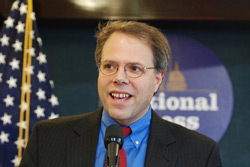
DAVID MASCI: On behalf of the Pew Forum, the Federalist Society, and the American Constitution Society, it’s my great pleasure to welcome you all to a discussion on the Supreme Court’s upcoming abortion cases: Gonzales v. Carhart and Gonzalez v. Planned Parenthood, which will be heard by the Supreme Court on Wednesday, November 8.
The Pew Forum is part of the Pew Research Center, and our mission is to provide timely information on important issues at the intersection of religion and public affairs. We’re nonpartisan, which means we don’t take positions on any topics, including the ones we’re going to be discussing today.
The Federalist Society is a group of conservatives and libertarians interested in law and public policy. It’s founded on the principles that the state exists to preserve freedom and that it is the province and duty of the judiciary to say what the law is, not what it should be. The society seeks to promote an awareness of these principles and to further them through its activities.
Finally, the American Constitution Society is one of the nation’s leading progressive legal organizations. Founded in 2001, ACS is comprised of law students, lawyers, scholars, judges and other concerned individuals who are working to ensure that the fundamental principles of human dignity, individual rights and liberty, equality and access to justice are all given their rightful central place in American law.
Today we’ll be talking about two closely related cases that involve challenges to the constitutionality of the federal Partial Birth Abortion Ban Act of 2003. These cases, Carhart and Planned Parenthood, offer the high court an opportunity to revisit issues it last addressed in 2000 in Stenberg v. Carhart, a five-to-four decision that struck down a Nebraska statute similar in many ways to the federal law being challenged now.
The Carhart in the 2000 decision and the Carhart named in the upcoming case are the same man, Leroy Carhart, a Nebraska physician who performs abortions. In the 2000 Stenberg case, the court invalidated Nebraska’s partial birth abortion ban, in part because it only contained an exception in cases when a woman’s life is in danger. It did not include a similar exception to protect a woman’s health. In addition, the majority in Stenberg found the wording of the statute to be to vague, ruling that it could be interpreted by doctors to include not only partial birth abortion but other abortion methods as well.
Three years after Stenberg, Congress passed the federal Partial Birth Abortion Ban Act, making it illegal for a doctor anywhere in the country to perform what opponents call a partial birth abortion unless the pregnant woman’s life is in danger. The statute was immediately challenged in several lower federal courts, all of which cited Stenberg in issuing injunctions barring enforcement of the act.
Dr. Carhart and the Planned Parenthood Federation of America, the parties in these current cases, as well as abortion rights advocates argue that the Supreme Court should let these lower court decisions stand. More specifically, they contend that the procedure they, as well as most of the medical community, call either dilation and extraction or intact dilation and evacuation, is medically necessary and that Stenberg and earlier Supreme Court decisions plainly require an explicit health exception. They also argue that federal law, like the Nebraska statute struck down in Stenberg, is too vague, and if enforced could end up banning other more common abortion procedures.
The Bush administration, which is defending this law, as well as anti-abortion advocates, contend that an abortion statute that does not explicitly contain a health exception, like this one, is not automatically invalid. It only runs afoul of prior Supreme Court precedent if it would create significant health risks for a woman seeking to terminate her pregnancy.
In this case, the administration argues, Congress included significant factual findings in the statute showing that partial birth abortion is never medically necessary and hence would not pose a health risk if it were banned.
Finally, the administration argues that the statute is not too vague, but is very precisely worded to ban only the so-called partial birth procedure.
Although it’s been six years since the Stenberg decision, changes in the composition of the high court in the last year raise the possibility of a different outcome in these cases. The recent retirement of Justice Sandra Day O’Connor, the fifth and deciding vote in Stenberg, and her replacement by the more conservative Samuel Alito create the prospect of a five-vote majority in favor of upholding the federal Partial Birth Abortion Ban and possibly even reversing the precedent set by the court in Stenberg.
On the other hand, no one knows how the new chief justice, John Roberts, and how Justice Alito himself will vote. Then there is Justice Anthony Kennedy, who wrote an impassioned dissent in Stenberg that suggests he would favor upholding the federal statute in the upcoming cases. However, some say he has moved to replace Justice O’Connor as the so-called swing vote on the court, which could conceivably lead to a shift in his position if, as is possible, the court is closely divided on this issue.
Here with us to examine these and other issue are four very distinguished experts.
First up will be Benjamin Bull, the chief counsel of the Alliance Defense Fund, a Christian-oriented public interest law firm that works on issues such as religious liberty and abortion. Before coming to the fund, Ben was a senior counsel for the American Center for Law and Justice, and general counsel at both the American Family Association Law Center and the Children’s Legal Foundation. He’s a graduate of the University of South Carolina Law Center.
Next up is Nancy Northup, president of the Center for Reproductive Rights. Before coming to the center in 2002, Nancy served at the Brennan Center for Justice at New York University School of Law, where she also taught constitutional law. She’s been a consulting attorney with the American Civil Liberties Union’s Reproductive Freedom Project and is a graduate of the Columbia Law School.
Also with us today is Helen Alvaré, an associate professor at the Catholic University School of Law. Helen also works as a consultant for the National Conference of Catholic Bishops’ Office of Pro-Life Activities. She is a graduate of the law school at Cornell University and has a master’s degree in theology from Catholic University.
Finally we’ll hear from Reverend Dr. Katherine Ragsdale, an Episcopal priest currently serving as vicar of St. David’s Church in Pepperell, Massachusetts, which Reverend Ragsdale tells me has about 150 congregants. Reverend Ragsdale has long been involved in reproductive rights and women’s rights advocacy, serving as chairperson on the national board of the Religious Coalition for Reproductive Choice. She is currently on the board of NARAL Pro-Choice America and sits on the advisory board of the Center for the Prevention of Sexual and Domestic Violence.
Let me also call your attention to a new legal backgrounder from the Pew Forum that analyzes the issues in the cases we’re going to discuss today. We’ve also issued a fact sheet on abortion laws in other countries, as well as an analysis by Stateline.org, also a Pew project, that examines abortion policy at the state level.
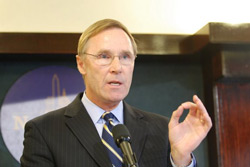
MR. BULL: What an honor it is to be here, and what an important case is coming up next week. I pose this question: Would the Roe court have ever imagined its decision would be stretched to the point where it would give constitutional protection for this kind of procedure? I submit it would not.
When you go back and look at the transcripts of the Roe arguments the second time it was argued, the state statute was defended by the attorney general of Texas. His name is Flowers. I’m going to read you a snippet of the transcript, and I think it is very eye-opening. Remember: The Texas statute that was not challenged in the Roe case was the Texas law banning partial birth abortion; the rest of the statute was challenged.
Here is Justice Marshall in the Roe case, asking the Attorney General Flowers this question: “What does that statute mean?” – meaning the partial birth abortion statute that was not challenged. Mr. Flowers: “Sir?” Justice Marshall: “What does it mean?” Mr. Flowers: “I would think that” – and he’s interrupted by Justice Stewart: “That it is an offense to kill a child in the process of birth?” Mr. Flowers: “Yes, sir, it would be immediately, before childbirth, or right in the proximity of the child being born.” Justice Marshall, “Which is not an abortion.” Attorney General Flowers: “Which is not – would not be an abortion. Yes, sir, you’re correct. Sir, it would be homicide.”
That’s the context in which the Roe court viewed the very procedure that is coming before the Supreme Court next week. A lot of pundits have spent an awful lot of time trying to guess which way the new justices are going to vote, but let’s look at the lineup and see if we can do a little crystal ball gazing ourselves.
We know that Justices Stevens, Ginsberg, Breyer and Souter have already staked out their positions. They’re going to vote that the federal law is unconstitutional under Roe. We also know that Thomas and Scalia are going to vote to affirm the constitutional law. Roberts, who replaced Rehnquist, is a wash in that Rehnquist voted with the dissent in Carhart. If Roberts is truly pro-life, as his reputation is, the pro-life side doesn’t gain anything because he simply steps into the shoes of Rehnquist, and they still don’t have a five-judge majority.
O’Connor was the fifth vote with the Carhart majority, and she’s gone. Who is she replaced with? Alito. Is Alito pro-life? As they say in Las Vegas, the smart money is that Justice Alito is going to vote to affirm the statute. He’s going to vote with the group that was the dissent in Stenberg.
So we have four to overturn the statute and four to affirm the statute. The swing vote is Justice Kennedy, as David just mentioned. Why is he in doubt? You remember looking back at Casey, which is probably the second most important abortion case after Roe. Casey was seen as the opportunity for O’Connor and Kennedy to join with the other conservatives and overturn Roe. They did not. They upheld a couple of procedures restricting abortion, but they reaffirmed all of Roe. The lead opinion in that case was written by Justice Kennedy.
But eight years later, in the 2000 Stenberg v. Carhart case, Kennedy broke with the majority, who he had joined in Casey and voted with Scalia and Thomas in dissent. In other words, he left Ginsberg, Stevens, Breyer and Souter and went over to Thomas and Scalia and Rehnquist, making a four-person dissent.
[Gonzales v. Carhart and Gonzalez v. Planned Parenthood]
What did Kennedy say in Stenberg that’s going to indicate the way he’s going to vote in this case? He said that the Nebraska ban on partial birth abortion does nothing more than represent the state’s profound interest in the protection of unborn life and poses no undue burden on the right of women to terminate their pregnancies through abortion. Stenberg is incompatible with his opinion in Casey, he says, because it doesn’t recognize the state’s constitutional power to protect the most innocent, the unborn.
In discussing the so-called D&X procedure, the partial birth abortion procedure, Kennedy says the partial birth abortion procedure is different from any other abortion procedure because the fetus “is killed outside the womb, where it becomes a person with autonomous constitutional rights.”
It’s almost as if he was angered by the majority’s decision in Stenberg, and he feels like he was stabbed in the back because he writes his dissent with great vigor. He goes back to the principle that it contradicts Casey‘s assurance that the state’s constitutional power to protect unborn life must be more than marginal. He criticized severely the Stenberg court awarding “veto power to abortion physicians over the judgment of the state on whether or not these procedures should go forward.” He said a health exception that does nothing more than ask the abortion physicians whether or not they should perform abortion is not meaningful, and that’s essentially what Stenberg did. It said you must have a health exception, and health exception is whatever the abortionists want it to be. That drove Kennedy nuts. He said this kind of exception swallows the statute and betrays his language and the majority of the judges who wrote the opinions in Casey.
Another important thing Kennedy said in Stenberg: He said there are no studies supporting the contention that the partial birth abortion procedure is any safer than any other kind of abortion procedure. Remember, this case next Wednesday is going to turn largely on whose studies are accepted by the court. Kennedy says, I’ve looked at them; there are no studies that show this is a superior procedure for purposes of health. He goes on to say: Assuming for the purposes of argument that everything the abortion provider said is true and everything the state of Nebraska and the amici have argued is false, at best in terms of physical safety, their evidence shows that partial birth abortion “makes only a marginal improvement.” If that’s all they’ve got, then the state’s profound constitutional interest in the protection of the child – the unborn child – trumps, and the state of Nebraska statute should have been approved.
Now ask yourselves, will Kennedy go with Ginsberg and Stevens and the others in striking down the statute, or will he remain truthful to his dissent in Stenberg and follow the positions he staked out there? The smart money in Las Vegas would say Kennedy forms a new majority with Scalia, Thomas, Roberts, and Alito affirming federal statute banning partial birth abortion.
(Applause.)
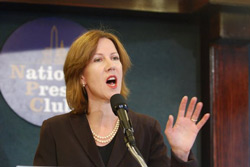
NANCY NORTHUP: Thank you so much to the Pew Forum and the Federalist Society and the American Constitution Society. As I was sitting here, I was thinking it is wonderful to be in this country where there can be such full and robust debate about these issues and to have organizations that can bring these differing views together.
As you have heard, both in the opening and also from Mr. Bull, we have been down this road before. And we really shouldn’t be going down this road again.
We’ve been down this road before about this term “partial birth abortion.” There is no such medical procedure as partial birth abortion. It is a political sound bite. The Center for Reproductive Rights brings cases both in the United States and around the world, and we don’t deal with this issue of partial birth abortion anywhere else in the world. That’s because it was created as a political sound bite for American politics. You heard it again this morning – “immediately before a child is born” was the term that Mr. Bull used. This case is about second-trimester abortions. That is all that this case is about. Babies are not born in the second trimester.
Third-trimester abortions are outlawed in most states around the United States as long as there is that constitutional protection for women’s life and health. This is not about babies about to be born. It is about safe procedures for women’s abortions in the second trimester. What this case at heart is about is whether the new Roberts-led Supreme Court is going to follow established law – that’s the settled law we heard so much about in the Supreme Court nomination hearings – and whether they are going to affirm that women having abortions in the second trimester can have the safest procedures for them. Just six years ago, the Supreme Court in Stenberg v. Carhart said, when confronted with Nebraska’s so-called partial birth abortion law, that doctors have to be able to use the safest procedures for their patients.
One of our clients, Dr. Leroy Carhart, has literally been down this road before. He’s a doctor in Nebraska. He challenged the Nebraska statute and took it to the Supreme Court six years ago. In so doing, the Supreme Court made those two very important determinations. Firstly, the Supreme Court said, this is drafted so broadly it would cover almost all abortion procedures in the second trimester, and therefore, it’s an undue burden on a woman’s right to access abortion in the second trimester, because she will be stripped of most options because doctors will not be able to provide the range of abortion services.
Secondly, the court said even if you were only talking about intact D&Es – and that’s the medical term – you’d still need an exception for women’s health, because there was substantial medical evidence that for some women it was a safer way to proceed with a second-trimester abortion.
Justice O’Connor was clear in her concurrence that you might be able to draft a constitutional ban on intact D&E if you did two things. First, she said, you would have to use medical terms. The Supreme Court went to great detail about talking about D&E abortions and intact D&E abortions. The majority said it would have been a simple matter for Nebraska to have used medical language that doctors understand when you’re hitting them with a criminal law. Second, Justice O’Connor said you would have to have a health exception. If you wrote these two things into the law – using medical terms and making sure that women can always have the safest abortions for them – you could probably draft a constitutional statute.
That was the Stenberg case in 2000. Congress got their hands on this issue and said to the Supreme Court, in effect, “We don’t care what you say about the constitutional requirements for women’s health. We’re going to pass a statute that is a deliberate attempt to gut the protections of Roe.” The chief Senate sponsor, Senator Santorum, during the process of the hearings, said, “I hope the justices read this record, because I am talking to you. There is no reason for a health exception.” So he was saying, “I don’t care that you just said women need to have the safest procedures. We, the Congress, are deciding that we do not want those guarantees for women’s health.”
Congress passed a law that once again used the political sound bite “partial birth abortion,” even though the Supreme Court said if you’re making criminal laws about medical procedures, then use medical terms. That created vagueness about what the law covers. And, as Senator Santorum guaranteed, there is no health exception. So women cannot have the safest procedures for them – procedures that would help them retain their ability to have children in the future.
This is a federal criminal statute. One of the things David didn’t mention about my past is for a number of years I was a prosecutor in the U.S. Attorney’s Office in the Southern District of New York. I know what it means to bring the power of the federal government into the lives of people when you’re investigating crime. As a former prosecutor, it’s frightening to think about the federal government having power to go into doctor’s offices and into the intimate details of medical decisions.
These cases were challenged, and the district courts all found the 2003 act to be unconstitutional. The circuits did as well. They did because they could easily follow the Supreme Court’s established law.
The federal statute has the same flaws as the Nebraska law. It is so vaguely worded that it covers abortions as early as 12 to 15 weeks, and it covers the majority of second-trimester abortions. Secondly, there is no health exception, as promised by Senator Santorum. If the Supreme Court reads its case law as well as the lower courts did, it should be an easily decided case. To speak to Justice Kennedy’s concerns about the prior case, the medical evidence now is even stronger than it was when Stenberg, v. Carhart was decided six years ago. In all the trials, you had leading physicians and doctors from academic institutions.
Congress said the intact D&E procedure is not taught in medical teaching hospitals; in fact, it is taught at leading hospitals such as Northwestern and Yale and Columbia and Cornell; the findings were flat out wrong. Congress also said there is a consensus against this. In fact, the American College of Obstetricians and Gynecologists, the leading organization of OB/GYNs, opposes this law because they believe intact D&Es can be the safest for women.
You have stronger evidence today than six years ago. This law is part of the agenda to overturn Roe v. Wade. Next Tuesday, obviously, we’re going to have an election. But when the dust settles, the court should be guided not by the changing political winds, but by a higher principle, the protection of individual rights. The Supreme Court in this case should send a clear message to the Congress that this is settled law, going back 30 years to when Roe established a bright line rule that pregnant women’s health may not be subordinated to opposition to abortion. That should be affirmed. Thank you.
(Applause.)
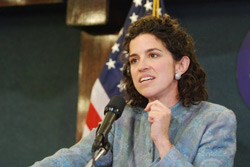
HELEN ALVARE: It’s a pleasure to be here today, and I thank you for the opportunity to speak on an issue I’ve worked on since 1994. At that time, I was with the Conference of Catholic Bishops, and there was a running joke in my office that because I was pregnant most of the 1990s, I would deliver while I was lobbying on this issue.
Because I was there from the beginning, I am happy to address the medical and ethical arguments that condition the two aspects of Justice Kennedy’s dissent and the upcoming case where his vote is so crucial. These two aspects are the weight of the state’s interest in this area and the meaning and the scope of the health exception.
When I first saw the paper in which Dr. Martin Haskell wrote about co-inventing what he called dilation and extraction, it was put on my desk by a colleague at the Bishop’s Conference who is well known to have an outrageous sense of humor. I assumed it was a joke, written as a kind of Jonathan Swift Modest Proposal – oh, right, now abortion providers have decided that it’s better to deliver babies first before killing them because that’s actually the safest thing for women. Soon, I learned it was real. This practice was done thousands of times a year, and that’s what got the ball rolling on the legislative effort.
I wondered, will abortion advocates defend this? Could they? Or will they see what we see, what everybody sees because of the nature of this procedure, which is a frail, small, human body, nearly completely delivered of the mother, stabbed, the contents of its head emptied, dying in front of everybody. Pro-lifers had assumed over the years that some large part of abortion advocates’ position was based on a failure of moral imagination, a failure to see inside the womb, a thinking that something that happened when a life was so small and hidden was somehow not a huge moral problem. But this procedure, whatever you call it, dilation and extraction or partially born and then aborted, is not hidden; it’s public for anybody to see. How could anyone defend it, I thought?
But of course I was immediately plunged back into the real world of abortion politics when the National Abortion Rights Action League, Planned Parenthood and others responded. Giving great weight to the idea that this is a horrific thing that everybody feels inclined to deny, the first thing they did was to deny it existed. They said it wasn’t a real procedure. Then they said if this medical sequence of events was performed, it was on babies who had died inside the mother who were only being taken out. This is all documented in various letters back and forth, mostly to the American Medical News. Then they claimed the baby was peacefully killed with high doses of anesthetics given before birth. So it wasn’t a brutal stabbing; it was a killing in the womb with certain anesthetics, and it was very peaceful and lovely, not to worry.
A leading pro-choice anesthesiologist appeared before Congress outraged, holding a crumpled page from Vogue magazine in which a pregnant patient of his who needed surgery would not undergo it because NARAL was telling her that this very dose of anesthesia would kill the baby. So that was disclaimed.
Finally, they began to move toward defending it. They said there were very few of them, that they only occurred in the second trimester, never in the third trimester, in a tiny fraction of cases. Doctors who did these abortions were interviewed, and in the pages of American Medical News and other papers said, no, I perform them into the third trimester. A pro-choice reporter in New Jersey said, no, there were thousands of them; the doctors have told me. So that argument went away.
Then it was claimed that it was done to save mothers’ lives when they carried babies like anencephalic or hydrocephalic children who somehow could not be delivered without ruining the mother’s future fertility. This was denied by the American Medical Association and even ACOG, who did end up opposing the ban – they couldn’t themselves think of a situation in which you needed it. The AMA called it not a medical procedure. This huge group of doctors whose whole job is delivering babies at high risk said, no, this was absolutely untrue. I sat beside these women who testified that is what their doctors have told them when the experts in fetal maternal delivery said it was not true.
You must remember that doctors like Doctor Carhart and those inventing partial-birth abortion have no specialized training in obstetrics and gynecology, none. The doctors who do say it’s never necessary.
We all know it would be even safer, rather than stabbing a sharp instrument near the mother to kill the child, just to deliver the child and kill him or her just 12 or 20 inches away, but that would be homicide. So why isn’t this?
Consequently, when these laws were passed, the pro-life community hoped because of what this was that abortion jurisprudence would not even be brought into the analysis. We said don’t use the Roe-Casey framework; it’s homicide. We argued that society ought to be allowed to draw a bright line between abortion and homicide, which is what Justice Kennedy and Justice Thomas so passionately argue on behalf of the states.
We said, yes, the same outcome is intended as an abortion, a dead infant. It is done in places that call themselves abortion clinics. They use the medical instruments that abortionists use, with some additions, but this is not abortion. When reporters used to call me and ask, “Why are you so exercised about the D&E abortion?” I would say, “Dilation and evacuation is dismemberment, and Justices Ginsburg, Stevens, Kennedy, and Thomas all use the word ‘grizzly’ to describe it.” Sometimes when they really weren’t getting it, I would say, “Location, location, location; it makes a difference.”
We couldn’t convince the judiciary that this procedure was a radical break with abortion itself. Still we thought surely they could see how dehumanizing it was. There was a very prominent nurse, Brenda Schafer, who would describe seeing it. I can never describe it anywhere without people absolutely coiling in upon themselves. It elicits that reaction. Abortion supporters’ immediate reaction to deny that it exists shows that they shared the same intrinsic reactions. It is no throwaway argument, as Justice Kennedy affirmed, to say that a state has an interest in not letting the medical community or mothers see or know that this is happening.
How did we hope that the nature of the act would affect the application of abortion jurisprudence proper, since we didn’t win the argument that it shouldn’t be applied in this case? First, we hoped that the states’ interests broadly shared interests – 30 states passed laws in rapid succession – would be seen as weighty as they are.
Justices Stevens and Ginsburg in their concurrence in Stenberg rejected this argument but in a very strange way, noting that because lawmakers claimed in this law to leave untouched the dismemberment procedure, which they said was also grizzly, that they weren’t accomplishing any vindication of state interests by banning partial birth; the child would still be killed.
We hoped the court’s black-hole-sized definition of the health exception announced in Roe and Casey would not be further extended. Roe and Casey say a state must allow abortion in all circumstances because they define health as all factors – physical, psychological, emotional, familial, or the woman’s age – right through the third trimester. But even this didn’t turn out to be broad enough for advocates of legal abortion who argued the health exception must also include the medical opinion of one man and a couple of other experts at trial, opposed by the AMA’s opinion, who said that in some circumstances that they might imagine, even though they didn’t do it themselves and didn’t know for sure, it might be medically necessary.
Our hopes for any commonsense understanding of the meaning of a woman’s health in connection with abortion were dashed in Stenberg. Even with this as the court’s currently operative definition, we thought we might win on account of the tiny fraction of abortions that even the Stenberg court said might have to be performed with this procedure, but we did not.
I would like to offer one final thought on this. After puzzling on it for 12 years as a woman who calls herself a feminist and believes it with every fiber of my being, I would like to see groups who are working on women’s rights issues stop focusing in on this issue so dramatically and do what women really need when it comes to the question of children.
Women need advice to respect their bodies and demand that men do the same. They need not to get pregnant without a marital situation that can support them in the long run. They need to be able to see children as the gift they are, not as threats, through public and private policies that pay a living wage and offer flexible hours when you need them.
If this seems very far from today’s topic, it’s only to help you understand how odd it is that partial birth abortion is what so many women’s rights groups are spending their time on. They should not be using the public’s sadly limited good will for women’s rights issues to focus in on this to say our rights hang on adding partial-birth abortion to the list of abortion procedures that doctors can do. Thank you very much.
(Applause.)
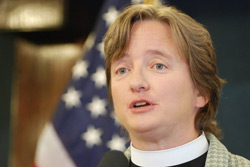
REVEREND KATHERINE HANCOCK RAGSDALE: I’ll start by acknowledging that I’m the only person here who is not a lawyer, at least on this side of the dais. So my presentation is apt to be a little bit different. Even not being a lawyer, I’m able to read – (laughter) – so I do know what some of the material is. While not being a lawyer, I share in common with Ms. Alvaré being involved in this issue from the beginning.
And from the beginning, there has been a concerted effort to muddy the waters and make it impossible to understand what this issue is really about. There has been a concerted effort to keep talking about this as if it were only about late-term, last-minute abortions, when in fact we know those procedures already are illegal in most states, except to protect the life and health of a woman. But in this case, we are talking about second trimester abortion. That is a long, long way – location, location, location – from infanticide.
I am an Episcopal priest in charge of a congregation. I have also, as a part of my ministry, spent over 20 years representing the Episcopal Church in the pro-choice movement. I spent 17 of those years on the board in the council of governors of the Religious Coalition for Abortion Rights – that’s what it was called when I started. It’s now the Religious Coalition for Reproductive Choice because we agree with Ms. Alvaré’s belief that women’s reproductive health includes things like ensuring living wages, jobs and childcare, teaching responsible sexuality, and valuing children. We changed our name so we can include all of those priorities. I spent 17 years on their board of directors in their council of governors, nine of them as chair.
But I’m here primarily — and I was there primarily — as a parish priest with an abiding concern for the people in my congregation. A third of the people in my congregation are children. We are really big on babies. If you pick up a prayer book and let it fall open, it falls over to the page of baptism. We do babies good.
I have an abiding care for those children and for the women in my congregation who are often faced with difficult choices and sometimes whose health is on the line with those choices. I do this work as a part of my ministry, and I am not an anomaly. It is not unusual that a person dressed like this, as a parish priest, should be making these arguments.
In terms of the here-we-go-again piece – I almost left this out because it seems like after saying it for 20 years people ought to get it. But apparently people don’t know that the vast majority of denominations and faith groups in this country are and have been pro-choice, have been for decades.
The religious coalition is a coalition of over 40 national religious organizations from numerous denominations and faith groups. It includes my church, the Episcopal Church; it includes the United Methodist Church, the Presbyterian Church, the reformed, the reconstructionist, and the conservative movements of Judaism, the American Ethical Union, the United Churches of Christ, the Unitarian Universalist Association, the Christian Church Disciples of Christ – I’m going to leave some out and not give you the entire list. But you can go to rcrc.org if you would like to see the whole list.
All of these denominations and faith groups are pro-choice, and most of them have been for decades. The Episcopal Church’s official pro-choice positions date to the 1960s, before Roe. In fact, we have a more recent resolution that speaks directly to the issue at hand here and opposes restrictions on this or any other form of abortion procedure that does not include an exemption for the life and the health of the woman.
We are pro-choice not in spite of our faith but because of our faith. We are pro-choice not because we think some political agenda should trump our faith commitments, but because as citizens, we believe we have the right, and as people of faith we believe we have the responsibility, to allow our consciences to govern our private lives. We are pro-choice not because we take human life or sexuality lightly but because we take them very seriously.
We believe that the lives of women matter. We believe that women who struggle to be faithful stewards of the gifts and talents God has given them, to be responsible parents to their children, responsible and productive members of society – women who face, wrestle with, make and live with complex decisions about if or when to bear children, if or when to carry a pregnancy to term, if or when abortion is necessary for their sake, their family’s sake, for the sake of their health – those women deserve our respect and our support, not some paternalistic attempt by the church or the state to intrude ourselves into these most personal, intimate decisions, much less to presume to determine the best medical practice to implement those decisions.
I am not a doctor, and neither is anyone else at this table, neither is Congress, and neither are the courts. We have no business telling doctors how to practice medicine.
We may have varying opinions about when or if abortion is ever an appropriate moral choice, but we’re very clear about who should make that decision. It is neither the church nor the government.
Faithful people, and even some denominations, disagree. Some oppose abortion under any circumstances, and some want the law to enforce their beliefs. Others allow for abortion under various circumstances, and some require it. Allow me for a moment to quote from the United Synagogues for Conservative Judaism: “Under certain unfortunate circumstances, such as when the life or health of the mother are in jeopardy, Judaism sanctions, even mandates, abortion.” To deny a Jewish woman and her family the ability to obtain a safe, legal abortion when so mandated by Jewish tradition is to deprive Jews of their fundamental right to religious freedom, which just illustrates that people of good faith and good conscience can and do disagree on this issue.
There is no moral consensus. We don’t agree about whether a fertilized egg, not yet implanted, ought to have civil rights that trump those of a woman, or whether that egg or blastocyst or embryo or fetus is a person yet. We don’t agree. What we ought to be able to agree on, though, is that the woman is a person, and that she is endowed by God, the United States Constitution, and common sense and decency with the right and responsibility to exercise control and care over her own body, to make her own moral decisions, and to protect her health.
This bill, which we all know is merely an incremental step in a campaign to ban all abortions, sacrifices the health of women to that campaign. Not only does it presume to step between a doctor and a patient in determining the best and the safest course of care, it disregards her health altogether. Women who choose an abortion, for whatever reason they deem legitimate and necessary, are forbidden by this ban from receiving what may be the safest procedure for them. Further, women who require an abortion, whose health is put at risk by their pregnancy, are also denied what may be the best medical practice to protect their fertility and their own health. It’s hard for me to understand how any person, religious or otherwise, could chose to require women to put their health at risk, to deny them the best medical care that their doctors can provide.
While it may be incomprehensible to me, some faithful people want to do exactly that, in the service, I presume, of what they see as a greater cause: eliminating abortion. They are, I suppose, entitled to their opinions and their belief. What they are not entitled to do — what is antithetical to everything this country was designed to stand for — is to impose one religious belief over others by force of law. This bill would do precisely that. This bill, as it stands, is an assault on religious freedom, an assault on the integrity of medical practice, an assault on the Constitution, and an assault on women, and we oppose it.
Instead, the religious coalition and its friend of the court brief, filed along with 34 other religious and religiously affiliated organizations, clergy and theologians, urges the court to heed the mandate of Casey to, quote, “define the liberty of all, not mandate its own moral code.”
Thank you.
Question & Answer

DAVID MASCI: One of the arguments made by this statute’s defenders is it’s different than the Nebraska statute struck down six years ago and contains extensive congressional findings establishing the health exception is not needed. That leaves open the possibility that the statute could be upheld and Stenberg could also survive.
BENJAMIN BULL: I think you’re absolutely right. The Congress took nine years, heard from every side, viewed the evidence, considered it, and came to the conclusion not only is a health exception not necessary, but this procedure, partial birth abortion, the so-called D&X procedure, is itself harmful to women. To put in an exception for health would have been an oxymoron, turning logic on its head.
Justice Kennedy agreed with that in his dissenting opinion in the Stenberg case. The question is: Is the Supreme Court going to believe the testimony of the abortion physicians like Dr. Carhart, or are they going to believe a roomful of documents and the testimony of experts on the other side saying this is a dangerous practice?
[during deliberations]
The majority of the five judges, minus O’Connor, won this case in 2000. They have no interest in granting review; they struck down a very similar Nebraska statute. Then who are the four judges voting to grant review? That’s what it takes to get cert. It had to be the dissent. Would they have voted to grant review if they didn’t think they had a more-than-reasonable chance of prevailing? I submit they do because they know which way Kennedy is going.
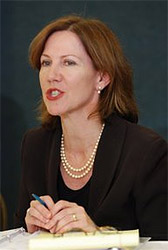
NANCY NORTHUP: I mentioned before that some of Congress’s findings were just flat-out wrong. For example, their finding that intact D&Es are never taught in medical schools – flat wrong; they are taught in leading academic schools such as Cornell and Columbia and Yale and Northwestern. Congress’s finding that there is medical consensus against intact D&E – flat wrong; the American College of Obstetricians and Gynecologists finds there can be safety benefits. Finding that intact D&Es risk women’s health – flat wrong. All three trial courts, which looked at the evidence extensively, found that Congress’s findings were unreasonable.
The district court in the Nebraska case found them unreasonable in and of themselves. We had nine years of hearings when the argument was in the Second Circuit. A lot of the evidence Congress had was before the Supreme Court in Stenberg v. Carhart because they had been having hearings all those years.
Importantly, one of the things that Judge Kopf said in the Nebraska case is that Congress’s findings were made without seriously examining the medical issues, and that they ignored furious dissention among doctors over the safety necessity of the disputed procedure. He went on to say, “This court heard more evidence during its trial than Congress heard over the span of eight years.” That included some of the government’s own witnesses. For example, the government witness, Elizabeth Shadigian, admitted under questioning that the procedures covered by the ban might become medically necessary. They also had one of their leading witnesses, the head of OB/GYN at Yale, saying that intact D&Es can be safer for women, and that the procedure will indeed be taught at the Yale Medical School.
There is a wealth of evidence that flies right in the face of what Congress found. For the court to defer here to Congress would be a complete abdication of their responsibility to define constitutional rights. Congress cannot just say white is black; it cannot just say slavery is freedom.
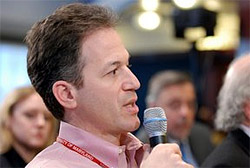
CHARLES LANE, WASHINGTON POST: Ms. Northup, in Kennedy’s opinion in Stenberg, he seemed to object to the idea the court was foreclosing a variety of views being enacted into legislation in different states; he objected to a one-size-fits-all rule being created by the majority. Does that portend a way for him to distinguish between these two cases? Here we have a federal rule that is creating one rule for the whole country.
NORTHUP: This case obviously raises the question of one rule for the entire country. More important, however, is the further development of the medical evidence in this case from six years ago, and from the Planned Parenthood v. Casey case, and from the third case brought by the National Abortion Federation and the ACLU in New York.
What you have six years later – and this will appeal to Justice Kennedy’s sense of wanting to pay attention to the medical evidence – are far more doctors with clinical experience and expert credentials in OB/GYN testifying about the safety befits of intact D&E. You have the fact that it’s taught at leading academic medical schools and in academic hospitals. You have the government’s own witness, Charles Lockwood, chair of OB/GYN at Yale, acknowledging that intact D&E might be the safest procedure in some circumstances. There is a wealth of evidence, and in fact the Nebraska court wrote a 474-page opinion to make sure they detailed exactly what that medical evidence is.
There is much more medical support now even than six years ago; this is not unusual because medical practice develops. It is going to be important for Justice Kennedy to see.

BULL: Some of the expert testimony presented by the abortion providers is somewhat humorous. It reminds me of the experts the tobacco industry put on the witness stand, saying that smoking cigarettes is actually good for you, and the more cigarettes you smoke, the healthier you’ll be. Partial birth abortion, they say, is good for you. It helps your health, and the more partial birth abortions you have, logically, the healthier you’ll be.
The testimony and evidence Congress pulled together is probably the most comprehensive collection of information about this procedure ever done. It’s overwhelming. If you look at the testimony in the trial courts, of the three cases before the Supreme Court, the government did a much better job of detailing exactly what this procedure is about: The baby is hanging out in the air, and the only thing not out in the air is its head. Scissors go into the head; it’s stabbed. The brains are sucked out and that’s it. If we’re really concerned about preserving and protecting the health of the mother and making a marginal improvement in her health, it’s marginally healthier for the mother to go ahead and give birth to the baby and have the abortionist just shoot it or drown it, if that’s the criteria we’re going to start using.
TONY MAURO, LEGAL TIMES: Mr. Bull, when you did your handicapping of the lineup of the justices, you didn’t give any weight to the force of precedent. Why don’t you think any of the justices in your majority will give credence to the fact that Stenberg is now law?
BULL: I do think that’s a significant factor. I had ten minutes to handicap them, and I would have spent more time on that topic. For Justice Alito stare decisis and not overturning settled law is very important. It’s also important to Kennedy. But we’re talking about Stenberg, a case that’s only six years old. We’re not talking about a case that’s been relied upon for generations. It’s going to go the way of Plessy v. Ferguson when Brown v. Board of Education overturned that.
Chief Justice Roberts is very conservative and not comfortable with overturning long-settled precedents. But on this one, because of the profound and grave moral issues surrounding it, he will be very comfortable overturning Stenberg, especially if Kennedy goes that way and provides cover.
[Kennedy]
BULL: The bright lines are pretty well drawn. The law is this statute is a firewall separating infanticide from abortion. If you move that line to the left any further, then you get in such forbidden territory there may be no return. No, I don’t see consensus here.
NORTHUP: The precedence issue isn’t just about Stenberg v. Carhart. It’s about the core commitment in constitutional law since Roe v. Wade, reaffirmed in Planned Parenthood v. Casey, that women’s health has to be the paramount concern when you’re regulating in the area of abortion. Casey reaffirmed the government can’t proscribe abortions that are “necessary in appropriate medical judgment for the preservation of the life or health of the mother.” It went on to say compliance with restrictive abortion law cannot “in any way pose a significant threat to the life and the health of the woman.” Stenberg v. Carhart was just extending that and applying it to a ban on a particular procedure, saying you had to have a health exception if substantial medical authority supports the proposition that banning the method could endanger women’s health. It’s not just Stenberg v. Carhart that is at stake, but a very important principle from Casey, going back to Roe, that women’s health has to be of paramount importance when you are passing restrictive abortion laws.
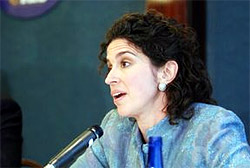
ALVARÉ: The Casey court and the Webster court took the Thornburg case, which was the Pennsylvania informed consent case, and said, we really did get into what even Sandra O’Connor called the “ad hoc nullification” of anything that touches on abortion. They were willing to undo Thornburg, and then later they were willing to undo Akron. It’s not wishful thinking to say Kennedy thinks his holding in Casey was betrayed, that not enough heft was given to a state’s serious interest. One of the congressional areas of findings that has been built up is the horror of the procedure.
[The procedure is done]
The health exception was read somewhat too broadly. In particular, the Casey holding urges us not to allow it to go that broad, because it would nullify what was said in Casey about a state’s solemn interest in life. It’s not too great a reach either for Kennedy or even for Alito or Roberts.
DENNIS CROWLEY, UNITED NEWS AND INFORMATION: Under what circumstances would a partial-birth abortion need to be performed over a regular type of abortion?
MASCI: We have no doctors, but does anyone want to take a crack at that?
[in Gonzales]
[cases]
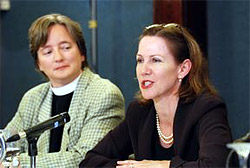
NORTHUP: Again, there’s nothing called partial birth abortion. There are second trimester abortions called D&Es; some of those end up being intact and some of those end up being dismemberment D&Es. There is a continuum of procedures that doctors may use when they start a surgical second trimester abortion, and they may not know when they begin the procedure whether or not it will result in being an intact delivery or not. The testimony at trial was that doctors often begin D&Es with the intention of removing the fetus as intact as possible. The goal is simply to minimize the number of instruments going into the uterus. Forceps are used in D&E procedures, and you want to minimize how many times an instrument passes into the uterus because it can cause laceration or perforation, hemorrhaging and other difficulties, which can compromise a woman’s ability to carry a child to the term in the future.
This discussion does not match what was discussed in the testimony by the doctors at trial. What was discussed there was a continuum of these second trimester abortion procedures. You want to be as minimally invasive as possible, and that’s why it’s done to protect women’s health. I would recommend to people a USA Today article this week by Joan Biskupic, which talked about a specific woman in Brooklyn who found out in her fourth month that she was carrying an anencephalic fetus, decided to have a termination of that pregnancy and was told by her doctor that it would be best have an intact D&E. She had that done in the second trimester and went on to have a third child, which was of great joy to her. But it’s an example of the actual real-life circumstances that women find themselves in. For people who are questioning why this might be safer or why someone might do this in the second trimester, it’s an excellent piece.
RAGSDALE: I would also add there is no such thing as partial-birth abortion. The language in this statute is so broad it makes it unclear precisely how many types of procedures are forbidden. But again, for a circumstance in which someone might require it, I refer you to the religious community’s amicus brief in the upcoming case, where they refer to several cases. In one in particular, Ms. Britell – her story is in the brief – deeply wanted a child. I’ve met her and talked with her about this procedure – a deeply wanted child that clearly was not going to be able to live, and for her health, the doctors recommended an induction abortion, that is, she was sent into labor to deliver. In the process of labor, she went into distress and the umbilical cord had to be cut upon delivery, thereby allowing the fetus to die after delivery. That is a procedure that would be illegal under this ban. It was required to save her life, to protect her health, and there was no chance of preserving the fetus in any case.
DANE VON BREICHENRUCHARDT, U.S. BILL OF RIGHTS FOUNDATION: My question goes to you, Reverend. If we were to ask Ms. Northup “when is a person a person?” she would, as an attorney, answer from a legal point of view. But you are a clergy person, an expert, I suppose, in the creation business; you are closer to the Creator maybe than the rest of us are.
[defenders]
RAGSDALE: Thank you for the attribution of expertise in the creation business. I do have a lot of education in theology, and sometimes one of the benefits of education is it teaches you what is unknowable. The mind of God is one of those unknowable things. When personhood is bestowed – not as a legal issue but as an existential issue – is a profoundly theological question on which well-educated, sincere, deeply committed, faithful people and theologians differ. The Roman Catholic Church would tell you “from the minute of fertilization.” Most other religious groups would probably not take it back that far. Jewish tradition would say from the moment of the first breath. I heard of a lovely Native American tradition that said “at the first laughter.” None of us ought to purport to be able to answer that question, and I’m sorry.
What we do know is that life is sacred in all of its manifestations. I’m not saying abortion is a trivial matter. I’m saying that a woman is clearly a person and her life is not a trivial matter; her health is not a trivial matter; her responsibilities to use the talents given to her by God are not a trivial matter. Making a decisions about when and if to bear children and when and if to have abortions are not trivial matters; they are deeply ethical and moral matters, and they ought not to be made by the courts, by the government. They ought not be imposed by any church other than that of her own choosing. Those decisions belong in the hands of the woman.
SUSAN WILLS, U.S. CONFERENCE OF CATHOLIC BISHOPS: Ms. Northup, You’ve made several claims I’d like to ask you about. First, you said that partial-birth abortion, or D&X, or intact D&E, or intact D&X – whichever terminology you prefer – is limited to the second trimester, and yet the two originators of the procedure, Dr. Haskell, and Dr. McMahon, have been quoted in American Medical News saying Dr. Haskell performs D&X abortions through 26 weeks of pregnancy, and Dr. McMahon said he performs them through all 40 weeks of pregnancy.
Secondly, you said the current lawsuit is flawed in that the statute suffers from the same vagueness the Nebraska statute suffered from, and yet nowhere have any of the speakers mentioned the exact terms of the statute, which refer to the delivery of a living fetus intentionally – if a feet-first delivery, past the navel, and if a head-first delivery, the entire head emerges from the mother before the abortion is performed – is an action that intends to kill the fetus, which it does.
Finally, you said that all three district courts supported the claims by abortion providers that there were legitimate health exceptions, but the New York court did not do so. Judge Casey found that the government’s witnesses successfully refuted the claims of the abortion-performing witnesses. He said that all of the reasons given by those witnesses in favor of partial-birth abortion were hypothetical, spurious, never clearly defined, and clearly refuted by the government witnesses.
NORTHUP: What I said was all three trial courts found Congress’s findings to be unreasonable. Second, on the question about vagueness: again, the trial courts in Nebraska and San Francisco found the definition in the statute could reach a range of abortions, including D&Es. It will be interesting to hear what the government says next Wednesday because they have been all over the place in what they say the breadth of the statute is. In their opening brief it reaches some non-intact D&Es, and there were briefs suggesting perhaps it could be limited. So the government itself has been all over the place. But two district courts found, when they examined this and heard the testimony, that it’s too broad. It reaches a range of D&Es in the second trimester.
Then the third question, my point is not that intact D&Es are not done in the third trimester; it’s that these cases are only about doctors who perform abortions in the second trimester. There are no third-trimester abortions at issue here. In our case in Nebraska, the judge found the injunction wasn’t going to extend to third-trimester abortions because there was no evidence the doctors were doing them.
BULL: At 23 weeks, of premature babies that are delivered, one third of them survive. At 24 weeks, one half live. Even if all these partial-birth abortions are done in the middle term, you are still talking about babies that, absent the killing of the child, would survive outside of the mother’s womb.
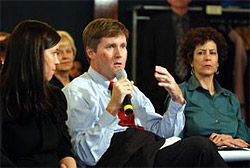
[Kennedy]
[include]
That is the struggle for him, and it’s a struggle that has been there since the health exception was passed. Many times pro-choice groups continue to say these abortions would be illegal in the third trimester anyway, but of course they are not with the health exception. Kennedy is struggling to maintain a health exception but to allow it to have some teeth; the health exception ought to be overwhelmed by the depth of the state interest here. At least that is how I read it.
NORTHUP: The rare time when a woman for her health or life needs an abortion in the third trimester is not the health exception at issue in this case. What’s at stake is when abortions are banned, what are the exceptions when a woman’s life and health is at risk.
Pre-viability abortions fall during the time the Supreme Court says women can make the decision about the termination of a pregnancy without an undue burden. Here we are not talking about a health need for the abortion; we’re talking about when women have decided to have an abortion in the second trimester, like the woman in the USA Today article. Can they have the procedure that is safest for them? The exception is if you are going to ban, say, intact D&E abortions in the second trimester, you have to allow doctors to say this is going to most likely preserve your fertility.
Helen has said twice now something about “marginal health benefits.” That’s not the constitutional standard. What the court said in Stenberg v. Carhart was that you needed a health exception when you criminalized an abortion method, if there was substantial medical authority to support the proposition that banning the method could endanger women’s health. This isn’t about some marginal trivial unimportant health benefit, and I think it’s an insult to the women who go through these procedures to suggest that. Substantial medical authority says this procedure can be safer in a real sense.
IRV CHAPMAN, BLOOMBERG RADIO: Mr. Bull, this procedure aside, are you saying to your wife, sister, daughter, others here present, that if a hospital full of doctors says you need an abortion to preserve your health, you still shouldn’t have it.
Ms. Northup, is the rather graphic description we heard of this procedure accurate or dead wrong?
Ms. Alvaré, you left me with the impression that first trimester abortions are okay. Are they?
ALVARÉ: I always know where that question is going. I remember getting asked in the Senate every once in a while, “Aren’t you really trying to chip away at Roe?” I would usually say, “You got me; here I am speaking, at that time, on behalf of the church, and you know that I really am against other abortions.” But no, today, we are really here to talk about partial-birth abortion. As if it would be any surprise that when I was with Conference of Catholic Bishops, or even now, as a person with moral convictions about respect for human life, that I wouldn’t oppose others.
What is before us now is really the dividing line between abortion and infanticide. Abortion supporters say they worry that if you do away with partial-birth abortion, then you’ll go backwards and get rid of abortion to the point of fertilization. Frankly what is happening today concerns these born-alive abortions, like the ones documented, for instance, in Chicago – letting children be born and then just leaving them to die from exposure and starvation. The partial-birth abortion law is meant to stop that.
NORTHUP: Your question was, is the description accurate? The descriptions in the medical literature about how D&Es and intact D&Es are performed, which are described in the Supreme Court case, would be the accurate description of the procedures. The trial courts have found the description – and the doctors testified – could chill them and make them concerned about performing a whole range of surgical abortions at the second trimester. I can’t support the descriptions we just heard and didn’t listen to every single word of them. But anyone can go to the Stenberg case, and they are accurate descriptions in the medical literature.
CHAPMAN: And Mr. Bull, if a hospital full of doctors says you’ll need an abortion to preserve your health?
BULL: This is like asking Michael Dukakis if your wife was raped, what would you do? That is not a legal question. We are here talking about partial-birth abortion. I would encourage everybody here to learn exactly what this procedure is. The only difference between a D&X, partial-birth abortion, and a D&E is that in a D&E, the doctor goes into the mother and basically cuts the baby into small pieces, and he has got to reassemble the child on a plate, on a table next to the mother. The risk is he might leave a finger or an arm in there, so he literally reassembles the child. Abortion doctors like the D&X, because they basically deliver the entire baby, except for the chin and the back of the head. They can see all of the parts are there, and then they kill the child at that moment, and don’t have to worry about lingering arms and legs in the womb.
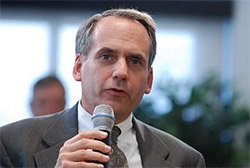
BOB RITTER, AMERICAN CONSTITUTION SOCIETY: The only thing in the Constitution I’m aware of in reference to persons alive or fetuses is the 14th amendment, which talks about persons born or naturalized. Isn’t that the standard rather than a fetus, which is not mentioned in the Constitution?
ALVARÉ: The analysis of the word “person” that went on in the Roe decision was asking a question of a document that was not written to address the abortion question. That is why it isn’t the answer, because that was not the question when that constitutional language was drafted. Most uses of the word “person” that they looked at in Roe had to do with things like naturalized citizens and who could be a senator or a member of Congress and so forth.
It was the wrong question, does the Constitution have anything to say about abortion? It wasn’t mentioned in there. What you had was a robust state tradition of banning it in most instances from a very early time in the republic.
NORTHUP: I’m not sure I totally follow the question, but the point is in Roe and reaffirmed later, the Supreme Court did say that for purposes of the 14th amendment, a fetus is not a person.
MASCI: I want to thank all of you for coming and for your excellent questions. (Applause.) I also want to thank our panel for their insightful testimony.
This transcript has been edited for clarity, style and grammar by Andrea Useem.




